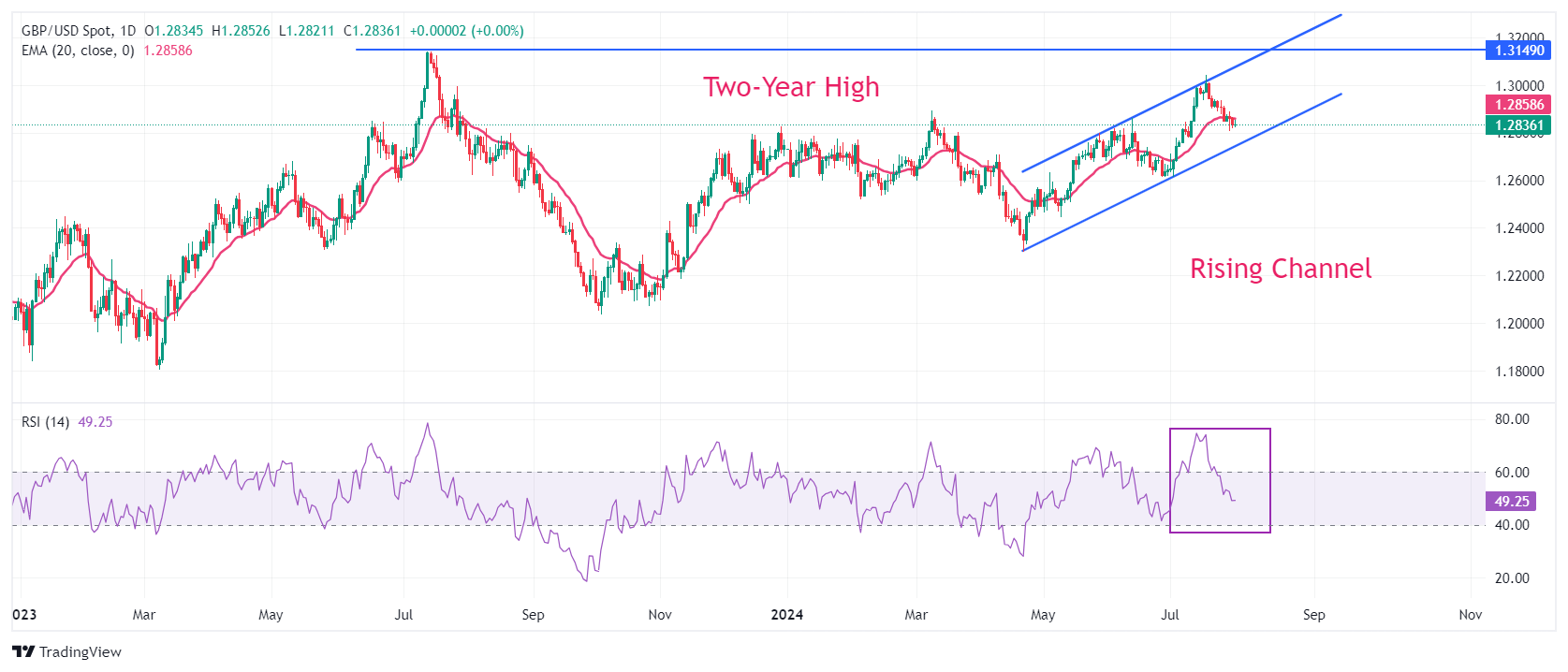- The British Pound fell near 1.2825 against the US Dollar ahead of the outcome of the Fed and BoE policy decisions.
- Strong speculation about BoE rate cuts on Wednesday has weighed heavily on the Pound.
- The US dollar plunges as the Fed is expected to deliver dovish interest rate guidance.
The British Pound (GBP) is weakening in London trading on Wednesday amid caution ahead of the Bank of England (BoE) interest rate decision, which is set to be announced on Thursday. The British currency is falling against its major peers except the Australian Dollar (AUD) as investors see the BoE cutting interest rates at the August meeting for the first time since March 2020. The BoE has maintained a tight monetary policy stance since December 2021 in an attempt to curb inflation, which was fueled by pandemic-related stimulus.
Market experts see the BoE cutting rates by 25 basis points (bps), a tough call as policymakers have been hesitant to back rate cuts due to high inflation in the services sector. UK annual services inflation rose steadily by 5.7% in June, higher than the bank’s forecast of 5.1% and roughly double the level needed to boost confidence in rate cuts.
Although expectations for BoE rate cuts have risen significantly, the central bank is less likely to commit to a specific path of policy easing amid firming momentum in wage growth.
Daily Market Wrap: Sterling falls on strong BoE rate cut bets
- The British Pound is down near 1.2825 against the US Dollar (USD) in the European session on Wednesday. GBP/USD is falling despite the weakness of the US Dollar, suggesting that the British currency is facing strong selling pressure. The Dollar Index (DXY), which tracks the value of the greenback against six major currencies, is down 0.2% at 104.20 on the day, with investors focused on the Federal Reserve’s (Fed) monetary policy, which is set to be announced on Wednesday at 18:00 GMT.
- The Fed is widely anticipated to keep interest rates unchanged in the 5.25%-5.50% range. This would be the eighth consecutive decision to keep key borrowing rates at their current levels since July 2023. Despite expectations of a steady rate decision, investors will remain vigilant as the Fed is expected to communicate a clear signal that rate cuts are around the corner.
- According to the CME FedWatch tool, 30-day federal funds futures price data show that the central bank’s 25 basis points (bps) rate cut at its September meeting is already priced in.
- Expectations that the Fed will begin to cut interest rates have been boosted by increased confidence that inflation will return to the bank’s 2% target. Confidence was fueled by lower-than-expected readings in the US (US) Consumer Price Index (CPI) data for May and June and a sharp slowdown in the second-quarter Gross Domestic Product (GDP) Price Index. In addition, subdued labor market conditions have strengthened speculation of rate cuts in September.
- On Wednesday, investors will also focus on ADP employment change data for July, due at 12:15 GMT. The report is expected to show that private sector labor demand remained stable as new payrolls were 150,000, in line with the June reading.
Technical Analysis: British Pound drops below 20-day EMA
The British Pound is gradually falling towards the lower boundary of an ascending channel chart formation on a daily time frame. The GBP/USD pair accelerated lower after breaking below the crucial support of 1.2900. Cable’s drop below the 20-day exponential moving average (EMA) near 1.2860 suggests uncertainty in the near-term trend.
The 14-day Relative Strength Index (RSI) is falling towards 40.00, which would be a cushion for the momentum oscillator.
On the downside, the round support level of 1.2800 will be a crucial support zone for the British Pound bulls. Meanwhile, the two-year high near 1.3140 will be a key resistance zone for Cable.
The British Pound FAQs
The Pound Sterling (GBP) is the oldest currency in the world (886 AD) and the official currency of the United Kingdom. It is the fourth most traded currency unit in the world, accounting for 12% of all transactions and an average of $630 billion a day, as of 2022.
Its key currency pairs are GBP/USD, also known as the “Cable,” which accounts for 11% of the forex market, GBP/JPY, or the “Dragon” as it is known to traders (3%), and EUR/GBP (2%). The British Pound is issued by the Bank of England (BoE).
The most important factor influencing the value of the British Pound is the monetary policy decided by the Bank of England. The Bank of England bases its decisions on achieving its main objective of “price stability”, i.e. a stable inflation rate of around 2%. Its main tool for achieving this is the adjustment of interest rates.
When inflation is too high, the Bank of England tries to contain it by raising interest rates, making credit more expensive for individuals and businesses. This is generally positive for the GBP, as higher interest rates make the UK a more attractive place for global investors to park their money.
When inflation is too low, it is a sign that economic growth is slowing. In this scenario, the BoE will consider lowering interest rates to make credit cheaper, so that companies borrow more to invest in growth-generating projects.
The data released gauges the health of the economy and can influence the value of the Pound. Indicators such as GDP, manufacturing and services PMIs, and employment can influence the direction of the Pound.
A strong economy is good for the British Pound. Not only does it attract more foreign investment, but it may encourage the Bank of England to raise interest rates, which will directly strengthen the British Pound. Conversely, if economic data is weak, the British Pound is likely to fall.
Another significant indicator for the pound is the trade balance. This indicator measures the difference between what a country earns from its exports and what it spends on imports during a given period.
If a country produces highly sought-after exports, its currency will benefit exclusively from the additional demand created by foreign buyers who wish to purchase these goods. Therefore, a positive net trade balance strengthens a currency and vice versa for a negative balance.
Source: Fx Street
I am Joshua Winder, a senior-level journalist and editor at World Stock Market. I specialize in covering news related to the stock market and economic trends. With more than 8 years of experience in this field, I have become an expert in financial reporting.








